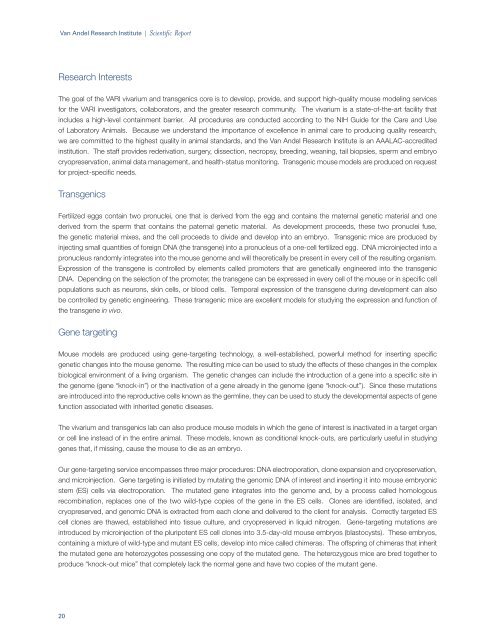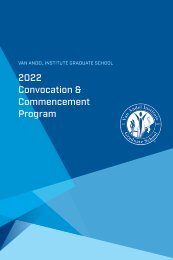2013 Scientific Report
Create successful ePaper yourself
Turn your PDF publications into a flip-book with our unique Google optimized e-Paper software.
Van Andel Research Institute | <strong>Scientific</strong> <strong>Report</strong><br />
Research Interests<br />
The goal of the VARI vivarium and transgenics core is to develop, provide, and support high-quality mouse modeling services<br />
for the VARI investigators, collaborators, and the greater research community. The vivarium is a state-of-the-art facility that<br />
includes a high-level containment barrier. All procedures are conducted according to the NIH Guide for the Care and Use<br />
of Laboratory Animals. Because we understand the importance of excellence in animal care to producing quality research,<br />
we are committed to the highest quality in animal standards, and the Van Andel Research Institute is an AAALAC-accredited<br />
institution. The staff provides rederivation, surgery, dissection, necropsy, breeding, weaning, tail biopsies, sperm and embryo<br />
cryopreservation, animal data management, and health-status monitoring. Transgenic mouse models are produced on request<br />
for project-specific needs.<br />
Transgenics<br />
Fertilized eggs contain two pronuclei, one that is derived from the egg and contains the maternal genetic material and one<br />
derived from the sperm that contains the paternal genetic material. As development proceeds, these two pronuclei fuse,<br />
the genetic material mixes, and the cell proceeds to divide and develop into an embryo. Transgenic mice are produced by<br />
injecting small quantities of foreign DNA (the transgene) into a pronucleus of a one-cell fertilized egg. DNA microinjected into a<br />
pronucleus randomly integrates into the mouse genome and will theoretically be present in every cell of the resulting organism.<br />
Expression of the transgene is controlled by elements called promoters that are genetically engineered into the transgenic<br />
DNA. Depending on the selection of the promoter, the transgene can be expressed in every cell of the mouse or in specific cell<br />
populations such as neurons, skin cells, or blood cells. Temporal expression of the transgene during development can also<br />
be controlled by genetic engineering. These transgenic mice are excellent models for studying the expression and function of<br />
the transgene in vivo.<br />
Gene targeting<br />
Mouse models are produced using gene-targeting technology, a well-established, powerful method for inserting specific<br />
genetic changes into the mouse genome. The resulting mice can be used to study the effects of these changes in the complex<br />
biological environment of a living organism. The genetic changes can include the introduction of a gene into a specific site in<br />
the genome (gene “knock-in”) or the inactivation of a gene already in the genome (gene “knock-out”). Since these mutations<br />
are introduced into the reproductive cells known as the germline, they can be used to study the developmental aspects of gene<br />
function associated with inherited genetic diseases.<br />
The vivarium and transgenics lab can also produce mouse models in which the gene of interest is inactivated in a target organ<br />
or cell line instead of in the entire animal. These models, known as conditional knock-outs, are particularly useful in studying<br />
genes that, if missing, cause the mouse to die as an embryo.<br />
Our gene-targeting service encompasses three major procedures: DNA electroporation, clone expansion and cryopreservation,<br />
and microinjection. Gene targeting is initiated by mutating the genomic DNA of interest and inserting it into mouse embryonic<br />
stem (ES) cells via electroporation. The mutated gene integrates into the genome and, by a process called homologous<br />
recombination, replaces one of the two wild-type copies of the gene in the ES cells. Clones are identified, isolated, and<br />
cryopreserved, and genomic DNA is extracted from each clone and delivered to the client for analysis. Correctly targeted ES<br />
cell clones are thawed, established into tissue culture, and cryopreserved in liquid nitrogen. Gene-targeting mutations are<br />
introduced by microinjection of the pluripotent ES cell clones into 3.5-day-old mouse embryos (blastocysts). These embryos,<br />
containing a mixture of wild-type and mutant ES cells, develop into mice called chimeras. The offspring of chimeras that inherit<br />
the mutated gene are heterozygotes possessing one copy of the mutated gene. The heterozygous mice are bred together to<br />
produce “knock-out mice” that completely lack the normal gene and have two copies of the mutant gene.<br />
20
















